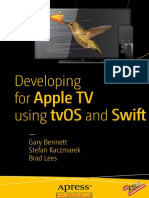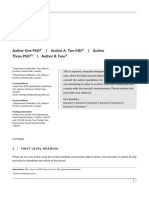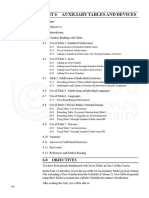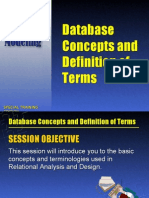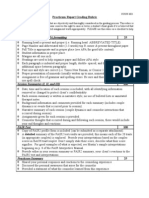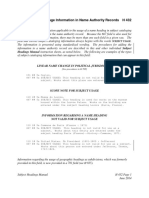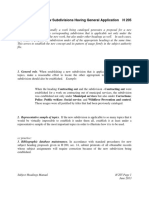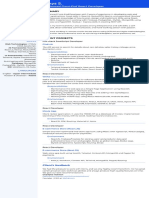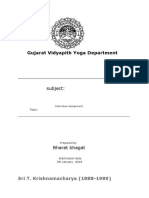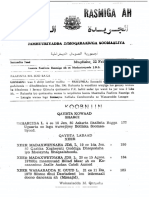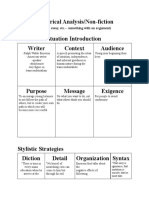Library of Congress Classification Numbers H 365 in Subject Authority Records
Library of Congress Classification Numbers H 365 in Subject Authority Records
Uploaded by
Fer GuCopyright:
Available Formats
Library of Congress Classification Numbers H 365 in Subject Authority Records
Library of Congress Classification Numbers H 365 in Subject Authority Records
Uploaded by
Fer GuOriginal Title
Copyright
Available Formats
Share this document
Did you find this document useful?
Is this content inappropriate?
Copyright:
Available Formats
Library of Congress Classification Numbers H 365 in Subject Authority Records
Library of Congress Classification Numbers H 365 in Subject Authority Records
Uploaded by
Fer GuCopyright:
Available Formats
Library of Congress Classification Numbers H 365
In Subject Authority Records
BACKGROUND: If one or more class numbers in the LC Classification system correspond
precisely with the idea represented by a subject heading, the number or numbers are put in 053
fields in the subject authority record, with qualifying terms if necessary and appropriate. This
instruction sheet provides principles and guidelines on when and when not to add LC class
numbers to subject authority records. For procedures on how to add class numbers to newly
proposed headings, see H 200, sec. 6. For procedures on how to add or change class numbers
in existing subject authority records, see H 196.
1. When to assign and when not to assign a number to a heading. Assign a class number to a
heading if:
! the caption for the number is identical or nearly identical in scope, meaning, and
language to the subject heading, or
! the topic is explicitly mentioned in an "Including" note under the caption for the
number, or
! the number is built by using Cutter numbers listed at another location in the
classification schedules or tables, or
! the topic belongs to a category for which it is standard LC classification policy to
classify works at a level that is broader than the subject headings assigned. For
example, the class number QL444.C74, (Harpacticoida) may be added to the subject
heading Harpacticidae (a family of Harpacticoida), because works on species,
genera, and families are all classed by order in QL444 rather than being individually
established. Similarly, the class numbers M 288-M289 (Duets for two wind
instruments) may be added to the subject heading Bassoon and flute music, because
individual numbers are not established in subclass M for every combination of
specific instruments.
Subject Headings Manual H 365 Page 1
June 2013
H 365 Library of Congress Classification Numbers
In Subject Authority Records
1. When to assign and when not to assign a number to a heading. (Continued)
Do not assign:
! a number representing a concept broader than, and encompassing, a specific heading.
For example, HV874.8-HV875.7, the numbers for Adoption should not be assigned
to the heading Open adoption, a topic for which a specific number has not yet been
established.
! a number for a general topic to a heading or heading-subdivision combination for a
specific aspect of the topic, even if the specific aspect classes in the general number.
For example, LB1028.35, the number for Instructional systems should not be as-
signed to the heading Instructional systemsBDesign, even though works on the topic
may have been classed in the general number. LB1028.35 should be assigned only
to its corresponding general heading, Instructional systems.
! a class number with a qualifier for a specific aspect of a topic to a general heading,
when the specific aspect is actually expressed by a free-floating topical subdivision
under the general heading. For example, the number RM666.R37 (Therapeutics)
should not be assigned to the heading Recombinant molecules because the number
actually corresponds to Recombinant moleculesBTherapeutic use.
Exceptions: For musical instrument headings, class numbers for history and/or
for instruction and study may be added to the authority records for the
instruments themselves. For literature headings, class numbers for collections
and/or for history and criticism may be added to the authority records for the base
headings. For headings that designate groups of people, class numbers for
biography may be added to the authority records for the headings.
! a class number in which a particular item (or the only item) on a topic has been
classed but whose caption does not directly correspond to the subject heading. For
example, RA785 with the caption Relaxation. Rest. Stress management should
not be assigned to the heading Worry beads, a topic for which a specific number has
not been established.
! a General special number to any subject heading, even if the topic is specified in an
including note.
H 365 Page 2 Subject Headings Manual
June 2013
Library of Congress Classification Numbers H 365
In Subject Authority Records
2. Cutter numbers. If the class number includes a Cutter number, provide the complete Cutter
(alpha portion and numeric portion). If it is editorial policy not to establish the Cutter number
in the schedule, do not provide an 053 field in the subject authority record.
3. Headings represented by spans of numbers. Designate the full range of numbers pertinent
to the heading, not merely the first number of the span or the General works number.
4. Qualifiers after class numbers. Qualify the class numbers unless the classification system
provides for the topic in only one place and is unlikely ever to provide for any aspect of it
elsewhere. Choose as the qualifier a term that designates the aspect of the topic that is classed
in the number, often a term taken from a higher level in the hierarchy of the class number, or the
title of the class or subclass. Example:
150 ## $a Molecular theory
053 #0 $a QD461 $c Chemistry
5. Headings represented by two or more different numbers. If two or more separate numbers
or spans of numbers are pertinent to the heading, enter each in a separate 053 field, and identify
each with the appropriate qualifying term. Arrange the 053s by class number alphabetically
and numerically. Examples:
150 ## $a Gold
053 #0 $a HG289 $b HG297 $c Finance
053 #0 $a HG551 $c Coinage
053 #0 $a QD181.A9 $c Chemistry
053 #0 $a TN410 $b TN429 $c Mineral resources
150 ## $a Legumes
053 #0 $a SB177.L45 $c Food plants
053 #0 $a SB203 $b SB205 $c Forage plants
053 #0 $a SB317.L43 $c General
Subject Headings Manual H 365 Page 3
June 2013
You might also like
- Developing For Apple TV Using TvOS and SwiftDocument134 pagesDeveloping For Apple TV Using TvOS and SwiftAlexandru NataliaNo ratings yet
- ICS SCADA Signatures SupplementalDocument84 pagesICS SCADA Signatures SupplementalMùa ThuNo ratings yet
- Wiley Journal TemplateDocument5 pagesWiley Journal TemplateMariaNo ratings yet
- Formal Lab Report - 9th GradeDocument7 pagesFormal Lab Report - 9th GradeNycoleBakerNo ratings yet
- Name Headings As Subjects H 430: RDA Aacr2Document4 pagesName Headings As Subjects H 430: RDA Aacr2Fer GuNo ratings yet
- Parenthetical Qualifiers in Subject Headings H 357Document2 pagesParenthetical Qualifiers in Subject Headings H 357Fer GuNo ratings yet
- Unit 6Document59 pagesUnit 6Suraj kumar BarnwalNo ratings yet
- Individual Essay Template1Document3 pagesIndividual Essay Template1Jhon EinarNo ratings yet
- Template For Assignment 5 - Research ReportDocument4 pagesTemplate For Assignment 5 - Research Reportkghlokwe06No ratings yet
- Peer Review CharterDocument2 pagesPeer Review Charterapi-341140786No ratings yet
- Enclosure NCR RAA SIP StylebookDocument12 pagesEnclosure NCR RAA SIP Stylebooklaurice327No ratings yet
- Manuscript FormatDocument2 pagesManuscript FormatTaNo ratings yet
- BLIE-227 Part-I ClassificationDocument18 pagesBLIE-227 Part-I Classificationvgurjar69No ratings yet
- Semi Stuctured Interview Data Collection and Analysis TemplateDocument8 pagesSemi Stuctured Interview Data Collection and Analysis TemplateVal SousaNo ratings yet
- T1 - CDD 23 - Vol 1Document31 pagesT1 - CDD 23 - Vol 1Jullyana AlmeidaNo ratings yet
- Naming Conventions - Table and ColumnDocument3 pagesNaming Conventions - Table and ColumnChristopher PNo ratings yet
- IB Economics 1 Assess.Document24 pagesIB Economics 1 Assess.Arbind KumarNo ratings yet
- General Guidelines: Guidelines Writing Bachelor or Master Thesis With The International Accounting GroupDocument7 pagesGeneral Guidelines: Guidelines Writing Bachelor or Master Thesis With The International Accounting GroupAkhlaq HussainNo ratings yet
- Sample Lab Name: Lab Partner #1 Lab Partner #2 (If Necessary) Submission DateDocument3 pagesSample Lab Name: Lab Partner #1 Lab Partner #2 (If Necessary) Submission DateJiggernoughtNo ratings yet
- Title: Informe Final: Asignatura Investigación en ProcesosDocument5 pagesTitle: Informe Final: Asignatura Investigación en ProcesosMafee VelezNo ratings yet
- Appendix B DAX ReferenceDocument174 pagesAppendix B DAX ReferenceTomislav Mališ100% (1)
- 0c3b9ed3 How To Write A Report MatDocument6 pages0c3b9ed3 How To Write A Report Matytpp7f6v7wNo ratings yet
- Instru Print 11095 020821Document11 pagesInstru Print 11095 020821Arfiani NurNo ratings yet
- Supporting Information PlaceholderDocument3 pagesSupporting Information Placeholderdallana0% (1)
- Changing A Heading or Deleting A Subject Authority Record H 193Document5 pagesChanging A Heading or Deleting A Subject Authority Record H 193Fer GuNo ratings yet
- Template Lab Report Mem460Document4 pagesTemplate Lab Report Mem4602022495898No ratings yet
- Cell Reports Author ChecklistDocument3 pagesCell Reports Author ChecklistJonathanNo ratings yet
- Author GuidelinesDocument4 pagesAuthor GuidelinesilaNo ratings yet
- Thesis Content Guidelines MACDocument3 pagesThesis Content Guidelines MACizeldien5870No ratings yet
- Thesis Appendix NumberingDocument4 pagesThesis Appendix Numberingrehyfnugg100% (2)
- TemplateDocument6 pagesTemplateAlessandro CavarrettaNo ratings yet
- Original Gata3Document15 pagesOriginal Gata3api-318191741No ratings yet
- Title: Type of The Paper (Article, Review, Communication, Etc.)Document6 pagesTitle: Type of The Paper (Article, Review, Communication, Etc.)henryvipxNo ratings yet
- Database Concepts and Definition of TermsDocument66 pagesDatabase Concepts and Definition of TermsMae Abigail Banquil88% (8)
- Science Manuscript Word TemplateDocument4 pagesScience Manuscript Word TemplatepopularsodaNo ratings yet
- Thesis Paper TemplateDocument17 pagesThesis Paper TemplateBenjamin L. StewartNo ratings yet
- Article Title: First Author, Second Author, Third AuthorDocument4 pagesArticle Title: First Author, Second Author, Third AuthorLaluNo ratings yet
- Commentary Peer ReviewDocument2 pagesCommentary Peer ReviewMayfair NgNo ratings yet
- BMP6001 Diss - Assessment 2 Brief - DissertationDocument9 pagesBMP6001 Diss - Assessment 2 Brief - DissertationIulian RaduNo ratings yet
- CMSC501 0 Proposal Template 1Document11 pagesCMSC501 0 Proposal Template 1DexterNo ratings yet
- Contents of A Thesis Dissertation Proposal - June 16 2018Document6 pagesContents of A Thesis Dissertation Proposal - June 16 2018Neil NaduaNo ratings yet
- Practicum Counseling Report Grading RubricDocument1 pagePracticum Counseling Report Grading RubricDeborah Ann Foster100% (1)
- Thesis TemplateDocument46 pagesThesis TemplateSofia ArqueroNo ratings yet
- Assessment 1 August 2024 DietDocument5 pagesAssessment 1 August 2024 DietMuhammad Bilal ZahoorNo ratings yet
- Assignment Writing GuidelinesDocument8 pagesAssignment Writing Guidelinesf6drrc5gznNo ratings yet
- 10.thesis Format and StyleDocument11 pages10.thesis Format and Styleblack armorNo ratings yet
- Your Paper's Title Starts Here: Please Center Use Times New Roman 14Document5 pagesYour Paper's Title Starts Here: Please Center Use Times New Roman 14Pilot QabachaNo ratings yet
- Template For Lab ReportDocument4 pagesTemplate For Lab ReportAhmed AliNo ratings yet
- List of Tables and Figures ThesisDocument8 pagesList of Tables and Figures Thesisbk1f631r100% (2)
- ItDocument2 pagesItvarsha TamhaneNo ratings yet
- Full Report GuidelinesDocument4 pagesFull Report GuidelinesGabriel Michaud-VerreaultNo ratings yet
- H0178 SerialsDocument1 pageH0178 SerialsFer GuNo ratings yet
- Partial Title Added EntriesDocument1 pagePartial Title Added EntriesFer GuNo ratings yet
- Original TemplateDocument7 pagesOriginal TemplateMawar LizaNo ratings yet
- Technical Report WritingDocument13 pagesTechnical Report WritingRana Mubasher100% (1)
- CLASSIFICATIONDocument65 pagesCLASSIFICATIONSu Jun MEj DaEnchuNo ratings yet
- Harvard ReferencingDocument3 pagesHarvard ReferencingsadeeswahajNo ratings yet
- report-writing_scientific-lab_detailed_2020Document6 pagesreport-writing_scientific-lab_detailed_2020yuzhangqinNo ratings yet
- DDC Crash Course HandoutDocument10 pagesDDC Crash Course HandoutAnne She-miNo ratings yet
- Jurisdictional Mergers and Splits H 710Document4 pagesJurisdictional Mergers and Splits H 710Fer GuNo ratings yet
- Chronological Headings and Subdivisions H 620Document9 pagesChronological Headings and Subdivisions H 620Fer GuNo ratings yet
- Subdividing Corporate Name Headings by Place H 475: LC IlsDocument1 pageSubdividing Corporate Name Headings by Place H 475: LC IlsFer GuNo ratings yet
- Subject Usage Information in Name Authority Records H 432Document2 pagesSubject Usage Information in Name Authority Records H 432Fer GuNo ratings yet
- Establishing Certain Entities in The H 405 Name or Subject Authority FileDocument16 pagesEstablishing Certain Entities in The H 405 Name or Subject Authority FileFer GuNo ratings yet
- Free-Floating Terms and Phrases H 362: Without Submitting Proposals To Establish Them in The Subject Authority FileDocument3 pagesFree-Floating Terms and Phrases H 362: Without Submitting Proposals To Establish Them in The Subject Authority FileFer GuNo ratings yet
- Nationality Designation of Classes of Persons H 350Document2 pagesNationality Designation of Classes of Persons H 350Fer GuNo ratings yet
- Establishing New Subdivisions Having General Application H 205Document1 pageEstablishing New Subdivisions Having General Application H 205Fer GuNo ratings yet
- Changing A Heading or Deleting A Subject Authority Record H 193Document5 pagesChanging A Heading or Deleting A Subject Authority Record H 193Fer GuNo ratings yet
- Field Work 1Document2 pagesField Work 1Rushikesh MargeNo ratings yet
- PDF CSTP 5 Timm 04Document10 pagesPDF CSTP 5 Timm 04api-678539949No ratings yet
- Denys S.Document1 pageDenys S.Vlada FelmNo ratings yet
- Asr04 HMM IntroDocument38 pagesAsr04 HMM IntroGetachew MamoNo ratings yet
- Jain Public School 14Document6 pagesJain Public School 14AnilGoyalNo ratings yet
- PRAF MICROCOMPUTER TECHNOLOGIES LTD. St. Kugel 40, P.O.B. 7209, Holon 58171, IsraelDocument510 pagesPRAF MICROCOMPUTER TECHNOLOGIES LTD. St. Kugel 40, P.O.B. 7209, Holon 58171, IsraelJimmy Coto ANo ratings yet
- Music Lesson Plan July - December 2024Document2 pagesMusic Lesson Plan July - December 2024Andry GarciaNo ratings yet
- CO3 Session 21Document8 pagesCO3 Session 21vivekdhanisetti2005No ratings yet
- Agc1 - 1Document4 pagesAgc1 - 1Thanh Trân0% (1)
- Gujarat Vidyapith Yoga Department: - SubjectDocument7 pagesGujarat Vidyapith Yoga Department: - Subjectjainsumit3No ratings yet
- Form 1 Mid t2 2018Document8 pagesForm 1 Mid t2 2018Joe KamashNo ratings yet
- List CompDocument2 pagesList Compal wkNo ratings yet
- LB Mystical SecretsDocument14 pagesLB Mystical SecretsEli KurtiNo ratings yet
- FR Fredy CanoDocument30 pagesFR Fredy CanoANDREA CAROLINA CASTILLO MENDIETANo ratings yet
- Linux TutorialDocument10 pagesLinux TutorialRadwa EhabNo ratings yet
- Sannadka Viii. Muqdisho - 22 Feb. 1980 - L. 2 R. 2Document43 pagesSannadka Viii. Muqdisho - 22 Feb. 1980 - L. 2 R. 2Cumar MaxamuudNo ratings yet
- f5-101 NewDocument16 pagesf5-101 NewSamir Jha100% (1)
- Bilingual Terminology Extraction Using Multi-Level Termhood: Chengzhi ZHANG, Dan WUDocument15 pagesBilingual Terminology Extraction Using Multi-Level Termhood: Chengzhi ZHANG, Dan WUchianmusNo ratings yet
- Bege 1041Document13 pagesBege 1041Elearning Quraan65No ratings yet
- 9 G ExamDocument6 pages9 G ExamOdayne MarshallNo ratings yet
- The Fruitcake Special Form 4 LiteratureDocument60 pagesThe Fruitcake Special Form 4 Literatureadefuwa kuroli67% (3)
- Rhetorical Analysis/Non-fiction Rhetorical Situation Introduction Writer Context AudienceDocument4 pagesRhetorical Analysis/Non-fiction Rhetorical Situation Introduction Writer Context AudienceSIERRA SILVERNo ratings yet
- An 2298Document14 pagesAn 2298خالدمحمدNo ratings yet
- M31Lx-Phonology - Final Exam - Fall 2019Document3 pagesM31Lx-Phonology - Final Exam - Fall 2019SOUFIYANE CHARRAOUNo ratings yet
- Mini Project For BSCIT 3rdDocument9 pagesMini Project For BSCIT 3rdMani ManuNo ratings yet
- English Area - Eba 2017: Alternative Basic EducationDocument3 pagesEnglish Area - Eba 2017: Alternative Basic EducationLorenzo Antonio Navarro BautistaNo ratings yet
- Instructional Week 13Document93 pagesInstructional Week 13Sheryl Joy PuriNo ratings yet
- Do Come Give Keep Make Put Tell: 3.5 CollocationsDocument2 pagesDo Come Give Keep Make Put Tell: 3.5 CollocationsBasil VagisilNo ratings yet
